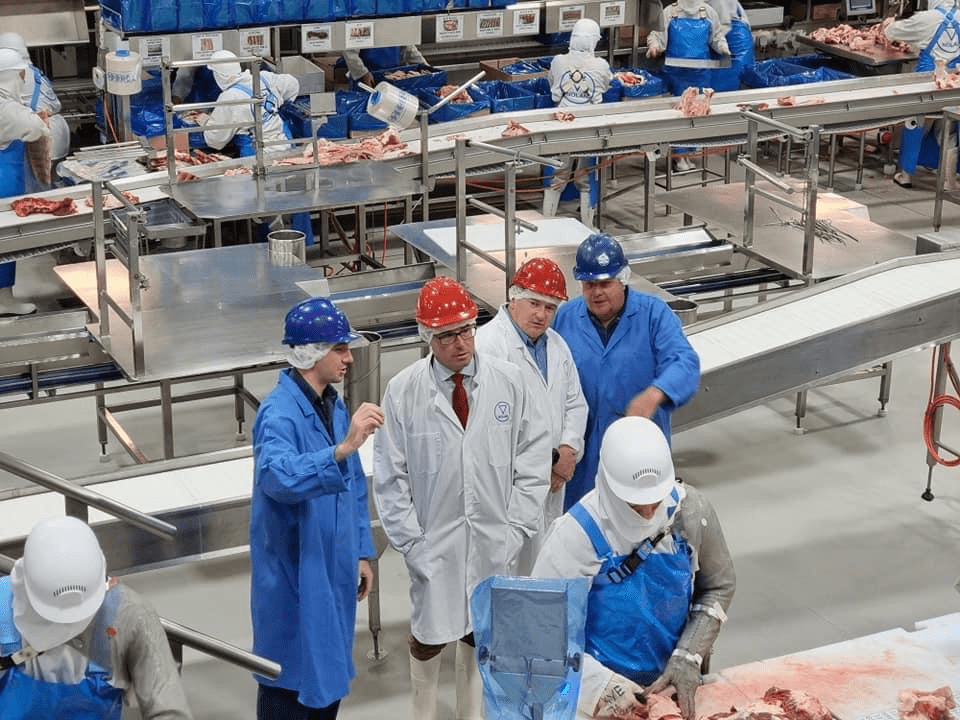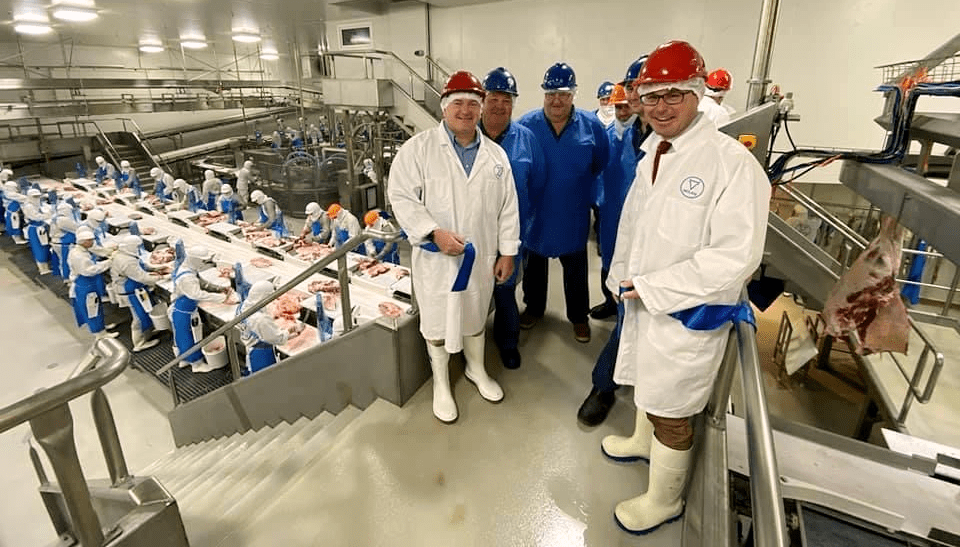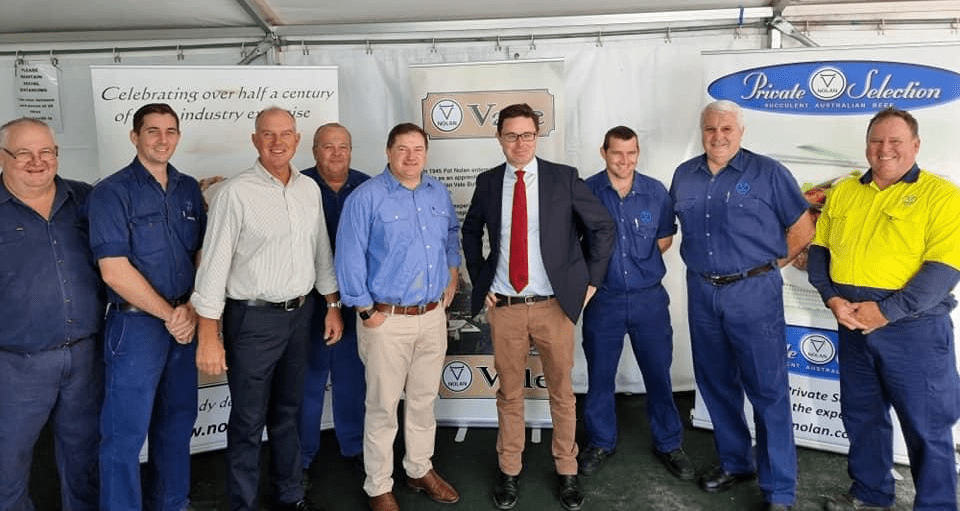
Agriculture minister David Littleproud inspects the new Nolan Meats boning room during yesterday’s official opening
QUEENSLAND export and domestic beef processor Nolan Meats yesterday unveiled its expanded and modernised boning room, featuring technology that is already delivering results in increasing carcase yield, and laying a platform for individual cuts traceability.
The $20 million project is the latest in a series of upgrades at the plant, designed to better match capacity through the facility’s kill-floor, coldroom and distribution centre, and boning room sections.
The new boning room was officially opened in a low-key ceremony yesterday by Federal Agriculture minister David Littleproud and Federal member for Wide Bay, Llew O’Brien. Click this link to view facebook post – https://www.facebook.com/llewobrienLNP/videos/124532396325584
Technology is a key feature in the project, with the first installation – outside of Europe – of Marel’s latest-generation SensorX Accuro trim management system, and Streamline boning line system.
Project coordinator Gerard Nolan (son of Tony), explained that the existing boning room was a production ‘bottle-neck’ for the facility, having earlier increased both kill-floor and distribution centre capacity.
“The existing boning room only had capacity to bone around 30 head per hour, while the expanded kill floor processes 60 head per hour and the DC commissioned in 2017 (see earlier Beef Central story) has capacity to handle 1100 cattle a day,” Mr Nolan said.
As a result, the business was operating under a single-shift on the kill-floor, while double-shifting the boning room each day, to keep pace.
With the expansion, boning capacity has now increased to 60/hour, matching the rest of the facility in a single shift. Extreme tight cattle supply and the scarcity of labour at present has meant that capacity is not currently being utilised, but it is ready once the national beef herd starts to recover.
An additional 84 staff positions are currently being filled in the new facility, with a likely 200 additional staff-members required when the plant again returns to full capacity.

Agriculture minister David Littleproud inspects the new Nolan Meats boning room during yesterday’s official opening
Marel system delivers performance tracking
Beyond simply being a larger, and functional working environment, the Marel technology incorporated into the Nolan boning room project provides the opportunity to closely monitor performance – both in terms of carcase yield from individual animals and suppliers, and also the working performance in terms of yield achieved from individual boners and slicers.
Squeezing another one or two percent meat yield from each carcase would over time go a long way towards paying for the investment, Nolans said. And that’s particularly important during times of extreme low herd numbers, like the present.
While not being utilised at this early point, the Marel system also has the capacity to deliver individual cuts traceability back to a specific animal and supplier, should the market demand it.
The new boning room incorporates quarter boning in the same way as the previous floor, but much greater use of scales and a sophisticated centralised conveyer belt system takes raw material to each appropriate work-station for slicing, and ultimately to the pack-off area. The new work station configuration has considerable advantages in terms of ergonomics for staff.
Encouraging early yield signs
While it is anticipated that there will be a 12-month bedding-down process for the new technology (Icelandic-based Marel has been unable to have its systems specialists on-hand for the commissioning phase, due to COVID international travel bans), already some highly encouraging signs are being seen.
Early boning room yield reports show that the boning room team has responded strongly to the challenge of performance recording, with primal yields currently 1pc up on previous performance.
The re-arrangement of the flow in the boning room, including the use of a dedicated bones belt, means that the plant is now routinely achieving 95pc carcase utilisation, up from the mid-to-high 70’s seen at times in the past in the old room.
Helping finance the project was a $4.9 million Federal Government allocation under the Regional Jobs Initiative, designed to create local employment opportunities. Planning for the project has extended over the past four or five years.
The design project management was handled internally by Nolans’ staff, with considerable work directed to local Gympie contractors. McVeigh Consultants handled the structural and architectural requirements, while the extensive conveyor belt systems were fabricated and installed by Comtec, out of Melbourne.
An enlarged high-volume Cryovac 8600 six-station vacuum packaging system has been installed in the enlarged facility.
In a unique construction approach, the structure of the new and enlarged boning room was built as a ‘shell’ around and above the existing boning room, while it was still being used – including installation of refrigeration and electrical work – allowing plant operations to continue without excessive disruption to production. When the project reached the final stage, the original boning room internal walls, ceiling and roof structure was removed, providing a reasonably seamless transition.
Much of the mechanical infrastructure installations were completed over the quiet December/January period, with a soft transition since then.
Like most boning rooms across Australia ‘of a certain age’, the old facility offered what could be described as ‘compact’ working conditions for staff as production volumes grew, but working space is now much more generous in the new facility.

Nolan brothers, Tony, far left, Michael, fourth from left, and Terry, second from right, with ag minister David Littleproud and staff and visitors during yesterday’s official opening
